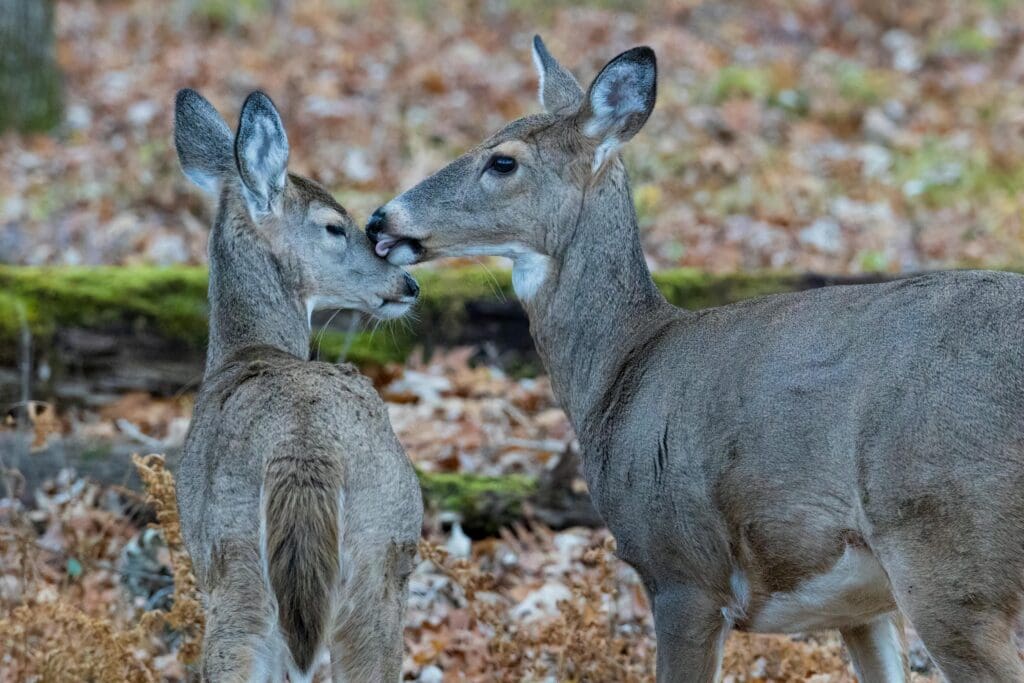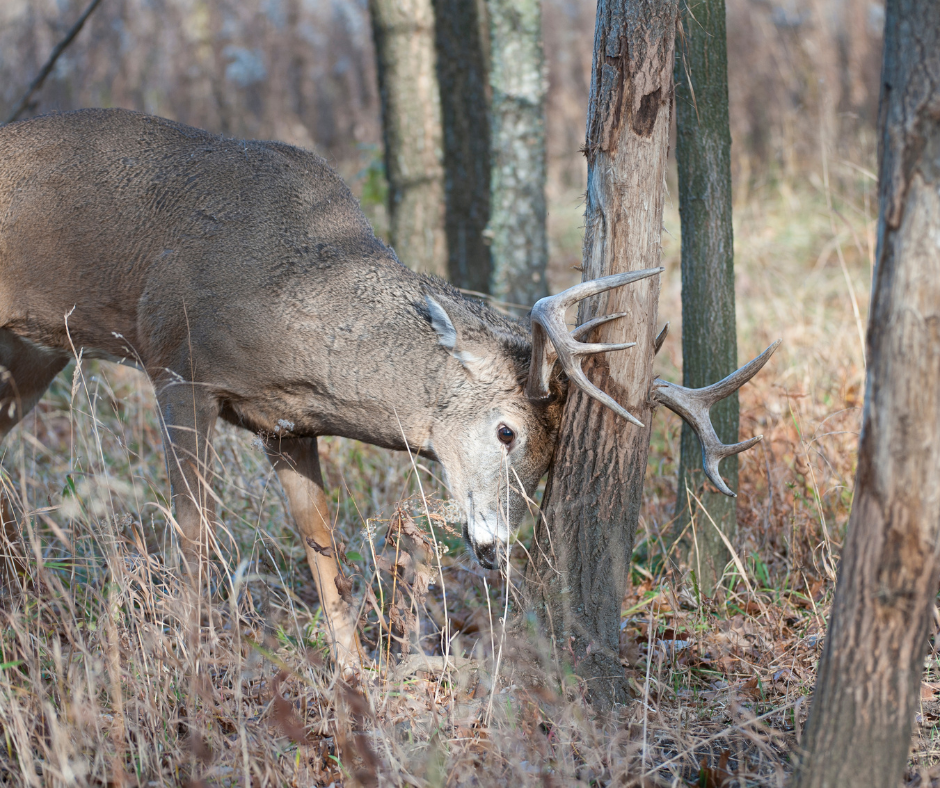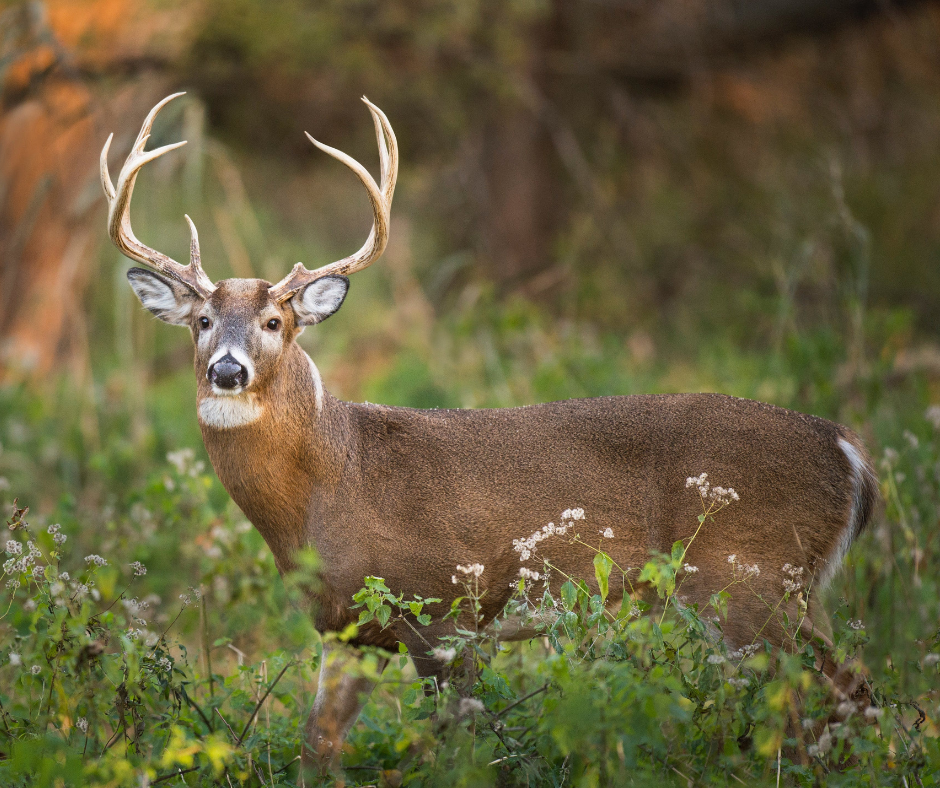

If you’ve ever spotted a deer freeze in your yard, flick its tail, or suddenly bound away, you’ve witnessed communication in action. But how do deer communicate, exactly?
Whitetail deer (Odocoileus virginianus) are among the most observant and adaptable wildlife in North America. Their survival depends on constantly reading and sending subtle cues to each other. Beneath their quiet presence lies a sophisticated communication system built on vocal sounds, body language, and scent marking.
Whether you’re a wildlife enthusiast, hunter, or homeowner curious about deer activity in your yard, understanding how deer communicate helps you interpret their behavior, and anticipate when they might cause damage to your landscape.
In this guide, we’ll break down the signals that make up the whitetail deer’s language of the forest.
When asking how do deer communicate, vocalizations are the most direct answer. Whitetail deer produce a variety of sounds that signal alarm, attract mates, and maintain contact between mothers and fawns.
1. Grunts
Bucks grunt frequently during the rut (breeding season) to assert dominance and announce their presence. A deep, rhythmic grunt can attract does while warning rival males. The tone and cadence often reveal the buck’s size and confidence.
Example: Hearing low, guttural grunts from the woods on a November morning likely means a buck is nearby, tracking a doe and claiming territory.
2. Bleats
Fawns bleat to call their mothers, especially when separated. Does also use gentle bleats to reassure fawns or to signal readiness to breed.
Example: A soft, sheep-like “maa” sound in tall grass during spring is a fawn calling for its mother.
3. Snorts
Perhaps the most recognizable deer sound, the sharp “blow” or snort signals alarm. When deer catch the scent of humans or predators, they exhale forcefully through their nostrils to warn others.
Example: If you hear a sudden “blow” at dusk, that’s likely a deer warning the herd, you’ve been detected.
4. Wheezes
Dominant bucks produce a raspy “wheeze,” often combined with a grunt-snort sequence, to challenge competitors. It’s one of the most aggressive vocal cues in deer communication.

While sound is important, deer rely even more on body language. These visual cues allow them to communicate without drawing predators’ attention, making them a vital part of how deer communicate in the wild.
Example: A deer flicking its tail while feeding feels secure. But if that tail suddenly shoots upright, danger is near, and the herd will quickly follow.
Deer can rotate their ears up to 180 degrees to locate sounds. Their ear direction and movement also serve as silent alerts to other deer, helping coordinate vigilance.

When unsure of a threat, a deer will stamp its front hoof to provoke movement or noise from a predator. Bucks also use postural displays, arching their backs, lowering their heads, and bristling fur, to communicate dominance without physical fighting.


Example: If you see a deer staring while stamping its hoof, it’s not just curious, it’s testing whether you’re dangerous.
Another fascinating way deer communicate is through grooming, also known as allogrooming, when one deer gently grooms another using its tongue and teeth. This behavior goes beyond hygiene; it’s a vital part of maintaining social bonds and herd harmony.

When deer groom each other, they typically focus on hard-to-reach areas such as the head and neck. This intimate contact shows mutual trust and affection, especially between mothers and fawns or among related does within a family group. Grooming helps reinforce social hierarchies while reducing tension within the herd.
Example: You might notice two deer standing close together, one licking the other’s neck or head. This isn’t random behavior, it’s a sign of familiarity and reassurance. The act communicates, “You’re part of my group. I trust you.”
Grooming also allows deer to exchange and spread scent from their specialized glands, strengthening group identity. In this way, grooming becomes another layer of how deer communicate through scent and touch, a subtle but powerful connection that maintains unity, especially during stressful times like fawning season or harsh winters.
One of the most fascinating answers to how do deer communicate, lies in scent. Deer have specialized glands that release pheromones, allowing them to “speak” chemically long after they’ve left an area.
During the rut, bucks create scrapes, pawed patches of soil where they urinate and leave glandular secretions. They also make rubs by scraping bark off young trees. These serve as both visual and olfactory messages to other deer.
Example: Bare soil spots near your property’s edge or bark stripped from ornamental trees are clear communication signs, deer are active, marking territory, and signaling to potential mates.

Unfortunately, these natural behaviors often lead to landscape damage, making deer control important for homeowners.
To fully grasp how deer communicate, you need to look at how their communication shifts depending on season and group structure.
Female deer (does) and their fawns form small family groups led by an experienced matriarch. They rely on soft bleats, tail flicks, and scent cues to stay coordinated and safe.

Male deer are typically solitary but become highly vocal and scent-driven during the rut, using grunts, wheezes, and rubs to compete and attract mates.

In winter, deer form larger herds for warmth and protection, communicating through subtle visual and scent signals to move and feed as a unit.

Learning how deer communicate isn’t just fascinating, it’s practical. Recognizing deer signals can help you predict their behavior and protect your landscape.
Example:
It’s October. You notice new tree rubs, hear distant grunts, and spot a scrape by your driveway. These are clear messages: deer are active, and your yard is part of their territory.
By identifying these signs early, homeowners can take steps, like all-natural deer deterrents from ohDEER, to prevent costly plant and tree damage.
So, how do deer communicate? Through a sophisticated blend of sounds, body movements, and scents that help them survive, reproduce, and maintain social order. Every grunt, tail flick, and tree rub carries meaning.
At ohDEER, we understand deer behavior from the inside out. Our All-Natural Deer Control strategies are built around how deer communicate and interact with their environment, so we can protect your yard while respecting the wildlife that lives nearby.
Learn more about whitetail deer in some of our other blogs:
Contact us today for a FREE Deer Assessment and learn how to keep your yard beautiful, safe, and deer-free, all while appreciating the remarkable communication of these intelligent animals.